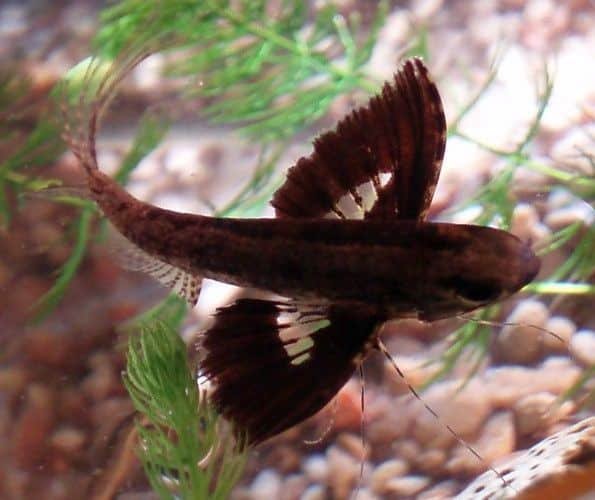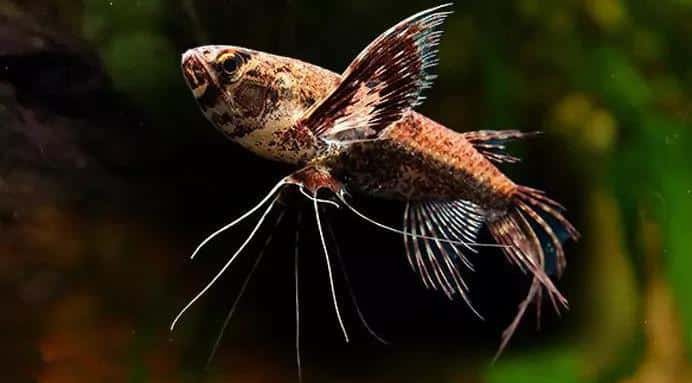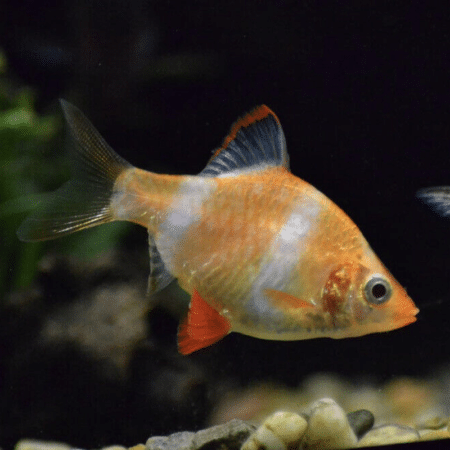Freshwater Butterflyfish – Pantodon buchholzi, Vibrant Aquarium Fish That Enhance Your Home, Easy Care Tips for Beginners, Promote Fish Compatibility and Healthy Tank Life
£21.49 Original price was: £21.49.£18.00Current price is: £18.00.
Welcome these beautiful freshwater butterflyfish (Pantodon buchholzi) into your aquarium! Their vibrant colors and graceful movements make them stunning community members. Perfect for aquarists seeking elegant tropical fish to enhance their freshwater setup. Easy care tips included.
Species Introduction
The Freshwater Butterflyfish, scientifically known as Pantodon buchholzi, is a captivating species native to the rivers and lakes of Central Africa. This beautiful fish is renowned for its unique appearance, characterized by its butterfly-like fins that create a stunning visual display as they swim gracefully through the water. Found primarily in the slow-moving waters of the Congo River basin, these fish thrive in environments rich in vegetation, where they can hide and hunt for food. The Freshwater Butterflyfish is not only a feast for the eyes but also a fascinating creature that adds a dynamic element to any community aquarium.
Care Requirements Dashboard
Essential Care Guide for Your Freshwater Butterflyfish
| Optimal Living Conditions | |
|---|---|
| Water Temperature | 24-27°C (75-81°F) |
| pH Level | 6.5-7.5 |
| Water Hardness | 4-12 dKH |
| Minimum Tank Size | 80L (20 gal) |
| Salinity | Freshwater |
| Care Level | Beginner Friendly |
Natural Behavior & Temperament
The Freshwater Butterflyfish exhibits a range of fascinating behaviors that make it a joy to observe. They are generally peaceful and can be welcomed in community tanks with other non-aggressive fish. Their natural swimming patterns involve gliding through the water column and occasionally darting towards the surface to catch insects. This species is known for its social nature, often forming loose schools with other Butterflyfish or compatible species. However, they can display territorial behavior, especially during breeding, so providing ample space and hiding spots is essential for maintaining harmony in the aquarium.
Tank Setup Guide
Creating an ideal environment for your Freshwater Butterflyfish involves replicating their natural habitat as closely as possible. Begin with a tank size of at least 20 gallons to allow for adequate swimming space. The substrate should be fine gravel or sand, which mimics the riverbeds they are accustomed to. Include plenty of live plants, driftwood, and rocks to provide hiding spots and create a sense of security. Floating plants can also be beneficial, as they offer shade and a natural hunting ground for these fish. Ensure that the aquarium has a gentle filtration system to maintain water quality without creating strong currents, as these fish prefer calm waters.
Water Quality Management
Maintaining optimal water quality is crucial for the health and well-being of your Freshwater Butterflyfish. The ideal pH range is between 6.5 and 7.5, with a temperature of 75-82°F. Regular water changes of 20-30% weekly will help keep the water parameters stable and remove harmful toxins. Monitoring ammonia, nitrite, and nitrate levels is essential; ammonia and nitrite should be at 0 ppm, while nitrates should remain below 20 ppm. Additionally, ensure that the hardness of the water is within the range of 5-15 dGH to provide a comfortable environment for these fish.
Feeding & Nutrition
Diet: Omnivorous
Freshwater Butterflyfish are omnivorous and thrive on a varied diet. They will enjoy high-quality flakes, pellets, and live or frozen foods such as brine shrimp, daphnia, and bloodworms. A feeding schedule of 2-3 times a day is recommended, providing only as much food as they can consume within a few minutes to prevent overfeeding and maintain water quality. It is important to observe their eating habits and adjust the diet accordingly to ensure they receive all the necessary nutrients for optimal health.
Compatibility Guide
The Freshwater Butterflyfish is known for its peaceful demeanor, making it an excellent addition to community tanks. Suitable tank mates include small to medium-sized fish that are not overly aggressive. Ideal companions include tetras, rasboras, and peaceful cichlids. However, it is essential to avoid larger, predatory fish that may see the Butterflyfish as a potential meal. When introducing new tank mates, it is advisable to monitor their interactions closely to ensure that all fish coexist harmoniously.
Health & Wellness
Common Issues: Minimal
Freshwater Butterflyfish are generally flourishing and resilient, but they can be susceptible to common freshwater diseases such as ich and fin rot if water quality is not maintained. Regularly observe your fish for signs of stress or illness, such as changes in behavior, loss of appetite, or visible lesions. Prompt action is crucial; if any health issues arise, consider isolating the affected fish and treating them in a separate quarantine tank. Maintaining good water quality and a balanced diet will significantly contribute to their overall health and longevity.
Breeding Information
Breeding Freshwater Butterflyfish can be a rewarding experience, though it requires specific conditions to succeed. These fish are egg layers and typically spawn in pairs. To encourage breeding, provide a separate breeding tank with soft, slightly acidic water and plenty of hiding spots. The female will lay eggs on flat surfaces, and the male will fertilize them shortly after. After spawning, it is essential to remove the parents to prevent them from eating the eggs. The eggs will hatch in about 24-48 hours, and the fry can be fed infusoria or finely crushed flakes until they are large enough to consume more substantial foods.
Acclimation Process
Introducing your Freshwater Butterflyfish to their new home requires a careful acclimation process to minimize stress. Begin by floating the sealed bag containing the fish in the aquarium for about 15-20 minutes to equalize the temperature. After this, gradually mix small amounts of tank water into the bag over the next hour. This process helps the fish adjust to the new water parameters. Once acclimated, gently release the fish into the tank using a net to avoid adding any transport water that may contain contaminants.
Long-term Care
Caring for your Freshwater Butterflyfish over the long term involves regular maintenance and monitoring of their environment. These fish can live for several years with proper care, so it is essential to maintain stable water conditions and a balanced diet. Regular water testing and changes, along with careful observation of their behavior and health, will ensure a thriving aquarium. Additionally, consider upgrading the tank size as your fish grow and their needs change, providing them with an optimal living space throughout their lifecycle.
Natural Habitat Recreation
To recreate the natural habitat of the Freshwater Butterflyfish, focus on creating a biotope that reflects their native environment. Incorporate a variety of plants, such as floating species and dense vegetation, to mimic the riverine ecosystems they inhabit. Adding driftwood and rocks will provide hiding spots and territorial boundaries, essential for their comfort. Aim for a well-planted tank that offers both open swimming space and secluded areas, allowing your Butterflyfish to exhibit their natural behaviors.
Seasonal Care Adjustments
As seasons change, so do the environmental conditions in your aquarium. During warmer months, ensure that the water temperature remains stable, as fluctuations can stress your Freshwater Butterflyfish. Use a heater if necessary to maintain consistent temperatures. In winter, monitor for cooling temperatures and adjust the heater accordingly. Additionally, consider adjusting the lighting duration to mimic natural daylight cycles, which can positively influence the health and behavior of your fish.
Expert Tips
Professional Advice
For optimal care of your Freshwater Butterflyfish, consider keeping a journal to track water parameters, feeding schedules, and any changes in behavior. This practice will help you identify patterns and make necessary adjustments to their care routine. Additionally, engaging with online forums and local aquarium clubs can provide valuable insights and support from fellow aquarists who share your passion for these beautiful fish.
Troubleshooting
If you encounter issues with your Freshwater Butterflyfish, such as unusual behavior or signs of illness, it is crucial to act quickly. Common problems include stress from aggressive tank mates or poor water quality. Always have a water testing kit on hand to monitor parameters and address any imbalances immediately. If your fish are exhibiting signs of illness, such as clamped fins or lethargy, consider consulting with an aquatic veterinarian for guidance on treatment options. Keeping a well-maintained aquarium will minimize most health issues.
Scientific Background
The Freshwater Butterflyfish belongs to the family Pantodontidae, which is known for its unique adaptations and characteristics. This family is distinct within the order Osteoglossiformes, which includes other notable freshwater species. Research on the ecological role of the Freshwater Butterflyfish in its native habitat has highlighted its importance in controlling insect populations and contributing to the biodiversity of river ecosystems. Conservation efforts are essential to protect their natural habitats, as pollution and habitat destruction pose significant threats to their populations.
Advanced Care Techniques
For experienced aquarists looking to enhance their care for Freshwater Butterflyfish, consider implementing advanced techniques such as live feeding and breeding setups. Offering live foods can stimulate natural hunting behaviors and improve their overall health. Additionally, creating a dedicated breeding tank with optimal conditions can lead to successful spawning. Advanced monitoring of water parameters using automated systems can also help maintain stability, ensuring a thriving environment for your aquatic companions.
Water Quality Parameters
Optimal Range
24-27°C
6.5-7.5
0 ppm
Caution Zone
22-24°C or 27-29°C
6.0-6.5 or 7.5-8.0
0.25-0.5 ppm
Danger Zone
<22°C or >29°C
<6.0 or >8.0
>0.5 ppm
Monitoring Tip: Test water parameters weekly and perform regular water changes to maintain optimal conditions for your aquatic friends!
Frequently Asked Questions
Q: What tank size is required for the Freshwater Butterflyfish?
The Freshwater Butterflyfish, Pantodon buchholzi, thrives in a minimum tank size of 100 litres. This spacious environment allows them to exhibit their natural behaviours, as they prefer to swim freely. A larger tank can help maintain stable water parameters and provide adequate space for swimming and hiding, which is essential for their well-being. It is also advisable to include floating plants or decorations that mimic their natural habitat, as they tend to feel more secure in such environments. Regular monitoring of water quality is crucial, as these fish are sensitive to changes in their surroundings. A properly sized tank will contribute significantly to their health and longevity.
✓ Expert Tip
Consider using a tank with a cover to prevent jumping, as these fish are known for their leaping abilities.
Q: What water parameters do Freshwater Butterflyfish require?
Freshwater Butterflyfish are sensitive to water conditions. Ideally, the pH should be maintained between 6.5 and 7.5, with a hardness range of 4-10 dGH. The temperature should be kept between 24°C and 28°C. Regular testing of these parameters is essential to ensure a healthy environment. Changes in water quality can lead to stress or illness in your fish friends. Additionally, maintaining a stable temperature and pH will help prevent shock during water changes. Using a quality water conditioner can also help neutralise harmful substances and promote a balanced ecosystem within your aquarium.
✓ Expert Tip
Invest in a reliable water testing kit to monitor parameters regularly, ensuring a stable environment for your fish.
Q: How often should I feed Freshwater Butterflyfish?
Feeding Freshwater Butterflyfish should occur 2-3 times a day, with small portions that they can consume within a few minutes. Their diet primarily consists of high-quality flakes or pellets, supplemented with live or frozen foods such as brine shrimp or daphnia to enhance their nutritional intake. Overfeeding can lead to water quality issues, so it is vital to observe their eating habits and adjust feeding amounts accordingly. Additionally, varying their diet can promote better health and colouration. Ensure that any uneaten food is promptly removed to maintain water quality.
✓ Expert Tip
Consider using feeding rings to prevent food from floating away too quickly, ensuring your fish have ample opportunity to eat.
Q: What are the best tank mates for Freshwater Butterflyfish?
When selecting tank mates for Freshwater Butterflyfish, it is crucial to choose peaceful species that occupy different water levels. Suitable companions include small tetras, rasboras, and some types of catfish. Avoid aggressive or large fish that may intimidate or outcompete them for food. Additionally, consider keeping them in a species-specific tank or with other gentle fish to reduce stress. Properly introducing any new tank mates is vital; always acclimatise them slowly to avoid territorial disputes. Monitoring interactions is essential, particularly during the initial introduction phase.
✓ Expert Tip
Introduce new fish in groups rather than singly to help diffuse any aggression and promote a more harmonious community.
Q: How do I properly acclimatise Freshwater Butterflyfish to my aquarium?
Acclimatisation is critical for Freshwater Butterflyfish to reduce stress. Start by floating the sealed bag containing the fish in your aquarium for about 15-20 minutes to equalise the temperature. Next, gradually introduce aquarium water into the bag, allowing the fish to adjust to the water parameters. This can be done by adding a small amount of tank water every 5-10 minutes for about an hour. Once acclimatised, gently release the fish into the tank without adding the bag water. Avoid sudden changes in environment, as this can lead to shock and health issues.
✓ Expert Tip
Utilise a drip acclimatisation method for more sensitive species, ensuring a slow and steady adjustment to their new environment.
Q: What are the signs of healthy Freshwater Butterflyfish?
Healthy Freshwater Butterflyfish exhibit vibrant colours, clear eyes, and active swimming behaviour. They should display curiosity and confidence when interacting with their environment. Observing their feeding habits is also essential; they should eagerly consume food without hesitation. Additionally, look for signs of stress such as hiding excessively or displaying faded colours. Regular monitoring and prompt attention to any behavioural changes can help prevent health issues. A well-maintained aquarium environment contributes significantly to their overall health and vitality.
✓ Expert Tip
Maintain a consistent routine for feeding and tank maintenance to help your fish thrive and exhibit healthy behaviours.
Q: How do I successfully breed Freshwater Butterflyfish?
Breeding Freshwater Butterflyfish can be challenging, but with the right conditions, it is achievable. Provide a separate breeding tank with plenty of floating plants for the fish to lay eggs. Maintain optimal water conditions, including a slightly lower temperature (around 24°C) during breeding. Introduce a pair of healthy adults, ensuring they are well-fed with high-quality food. Once spawning occurs, the parents should be removed after laying eggs to prevent them from eating the eggs. The eggs typically hatch within 2-3 days, and the fry require fine food like infusoria until they are large enough for small brine shrimp.
✓ Expert Tip
Maintain a separate breeding tank to reduce stress on the parents and improve breeding success rates.
Q: What temperature should I maintain for Freshwater Butterflyfish?
The ideal temperature range for Freshwater Butterflyfish is between 24°C and 28°C. Maintaining a stable temperature is crucial, as fluctuations can lead to stress and health issues. Using a reliable aquarium heater with a thermometer will help regulate the temperature effectively. It is advisable to avoid placing the tank in direct sunlight or near drafts to prevent temperature fluctuations. Regularly monitoring the temperature will ensure a comfortable environment for your aquatic companions, promoting their well-being and longevity.
✓ Expert Tip
Consider using a heater with a built-in thermostat for added convenience and temperature stability.
Q: How long do Freshwater Butterflyfish typically live in captivity?
In captivity, Freshwater Butterflyfish can live up to 5-10 years with proper care. Factors contributing to their longevity include stable water conditions, a balanced diet, and a stress-free environment. Regular health checks and prompt treatment of any health issues will also enhance their lifespan. Ensuring that they have suitable tank mates and a well-maintained aquarium will further promote their well-being. By providing optimal living conditions and attentive care, you can enjoy the beauty of these fish friends for many years.
✓ Expert Tip
Document their growth and behaviour to monitor their health and ensure they are thriving in your care.
Q: What type of substrate is most suitable for Freshwater Butterflyfish?
For Freshwater Butterflyfish, a soft substrate such as sand or fine gravel is ideal. This type of substrate helps mimic their natural habitat and allows for easy movement and foraging. Avoid sharp or coarse substrates, as these can injure their delicate bodies. Additionally, providing a variety of hiding spots and decorations will create a comfortable environment for your fish friends. Regular cleaning of the substrate is essential to maintain water quality and prevent the build-up of harmful waste, contributing to a healthy aquatic ecosystem.
✓ Expert Tip
Consider using a siphon to clean the substrate during water changes, ensuring a thorough removal of debris.
Q: What behavioural patterns should I expect from Freshwater Butterflyfish?
Freshwater Butterflyfish are known for their unique behaviours, including gliding and leaping above the water surface. They are generally peaceful but may exhibit territoriality during breeding. You may observe them resting near the surface or hiding amongst plants, which provides them a sense of security. These fish are also quite curious and will explore their surroundings, often interacting with tank mates. It is essential to provide plenty of swimming space and hiding spots to accommodate their natural behaviours and reduce stress levels.
✓ Expert Tip
Enhance their environment with floating plants to encourage natural behaviours and provide hiding spots.
Q: How can I prevent common diseases in Freshwater Butterflyfish?
Preventing diseases in Freshwater Butterflyfish begins with maintaining optimal water quality. Regular water changes, monitoring parameters, and ensuring proper filtration are essential. Quarantining new fish before introducing them to your main tank can also prevent the spread of diseases. Additionally, providing a balanced diet and avoiding overfeeding will help strengthen their immune system. Keep an eye out for signs of stress or illness, such as changes in behaviour or appearance, and address any issues promptly. Regular health checks are vital for early detection and treatment.
✓ Expert Tip
Perform routine checks for any signs of illness or parasites, and consult a professional if any concerns arise.
Q: What lighting conditions do Freshwater Butterflyfish prefer?
Freshwater Butterflyfish thrive under moderate lighting conditions. Too bright light can cause stress, so incorporating floating plants can help diffuse light and create shaded areas. A light cycle of around 10-12 hours a day mimics their natural environment and promotes healthy growth of live plants, if included. It is essential to avoid direct sunlight, as this can lead to overheating and excessive algae growth. Using adjustable LED lights allows you to create a suitable environment for both the fish and any live plants in the aquarium.
✓ Expert Tip
Consider using a timer for your lighting system to maintain a consistent light cycle, reducing stress for your fish.
Q: How do I recognise stress in Freshwater Butterflyfish?
Signs of stress in Freshwater Butterflyfish include hiding excessively, lethargy, and changes in colouration. You may also notice them swimming erratically or exhibiting rapid gill movement. Stress can result from poor water quality, aggressive tank mates, or sudden changes in the environment. It is crucial to monitor their behaviour and address any issues promptly. Providing a well-maintained tank with ample hiding spots and compatible tank mates will significantly reduce stress levels and promote a healthy, thriving environment for your fish friends.
✓ Expert Tip
Regularly observe your fish’s behaviour and environment to catch any signs of stress early and take appropriate action.
Q: What natural habitat conditions should I replicate for Freshwater Butterflyfish?
Freshwater Butterflyfish originate from slow-moving waters in Africa, typically found in rivers and lakes with plenty of vegetation. To replicate their natural habitat, include floating plants and subdued lighting in your aquarium. Maintain a slightly acidic to neutral pH and ensure stable water temperatures between 24°C and 28°C. Incorporating driftwood and rocks can also provide hiding spots and create a more natural environment. Regular water changes and monitoring of water parameters will help maintain optimal living conditions for your fish.
✓ Expert Tip
Consider using a natural aquarium substrate to enhance the aesthetic and mimic their natural environment.
















Liam Rodriguez (verified owner) –
I recently added the Freshwater Butterflyfish (Pantodon buchholzi) to my aquarium, and I couldn’t be happier! These beautiful tropical fish add an enchanting charm to my tank with their stunning colors and unique butterfly-like shape. I’ve had them for about two months now, and they’ve acclimated beautifully. They glide gracefully through the water, making my aquarium feel alive! What I love most is how they interact with their environment; they dart around and occasionally surface, which is always a delight to watch.
Compared to other freshwater fish I’ve kept, the Butterflyfish has a distinct personality and seems to thrive in my well-planted tank. They prefer softer, slightly acidic water, which I easily maintain with my setup. A quick tip for anyone considering this species: ensure you have plenty of open swimming space and hiding spots!
The shipping was quick, and the fish arrived healthy, which is crucial for me as a caring fish parent. If you’re looking to enhance your aquarium with a captivating species, I highly recommend the Freshwater Butterflyfish. Just be sure to do your research and create a comfortable environment for them to flourish!
Laura Mitchell (verified owner) –
I recently added two Freshwater Butterflyfish (Pantodon buchholzi) to my aquarium, and I couldn’t be happier! As a caring fish parent, I’m always on the lookout for species that not only look great but also thrive in a community setting. These butterflyfish are simply stunning with their vibrant colors and unique shape. They’ve been in my tank for about a month now, and I can genuinely say they bring a new level of activity and charm to my tropical fish environment.
One of the things I appreciate most is how well they get along with my other fish. I’ve noticed that they interact playfully with my tetras and guppies, creating a lively atmosphere that makes my aquarium a focal point in my living room. Their gentle nature and peaceful temperament make them perfect for beginners and seasoned aquarists alike.
While they enjoy a bit of space to swim, I did find that they prefer a slightly dimmer light, so I added some floating plants, which they adore. If you’re considering these gorgeous fish, I highly recommend ensuring you have some cover for them to feel secure. Overall, I highly recommend the Freshwater Butterflyfish for anyone looking to enhance their aquarium with beautiful, compatible tropical fish. You won’t regret it!